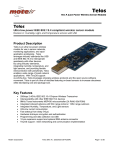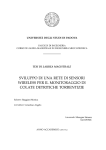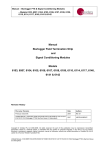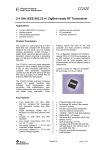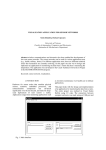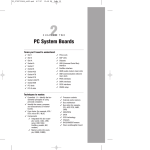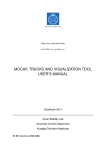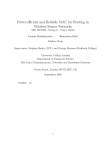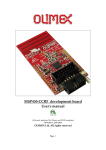Download moteiv Telos Datasheet
Transcript
Low Power Wireless Sensor Module Ultra low power IEEE 802.15.4 compliant wireless sensor module Humidity, Light, and Temperature sensors with USB Product Description Tmote Sky is an ultra low power wireless module for use in sensor networks, monitoring applications, and rapid application prototyping. Tmote Sky leverages industry standards like USB and IEEE 802.15.4 to interoperate seamlessly with other devices. By using industry standards, integrating humidity, temperature, and light sensors, and providing flexible interconnection with peripherals, Tmote Sky enables a wide range of mesh network applications. Tmote Sky is a drop-in replacement for Moteiv’s successful Telos design. Tmote Sky includes increased performance, functionality, and expansion. With TinyOS support out-of-the-box, Tmote leverages emerging wireless protocols and the open source software movement. Tmote Sky is part of a line of modules featuring on-board sensors to increase robustness while decreasing cost and package size. Key Features • • • • • • • • • • • • • 250kbps 2.4GHz IEEE 802.15.4 Chipcon Wireless Transceiver Interoperability with other IEEE 802.15.4 devices 8MHz Texas Instruments MSP430 microcontroller (10k RAM, 48k Flash) Integrated ADC, DAC, Supply Voltage Supervisor, and DMA Controller Integrated onboard antenna with 50m range indoors / 125m range outdoors Integrated Humidity, Temperature, and Light sensors Ultra low current consumption Fast wakeup from sleep (<6μs) Hardware link-layer encryption and authentication Programming and data collection via USB 16-pin expansion support and optional SMA antenna connector TinyOS support : mesh networking and communication implementation Complies with FCC Part 15 and Industry Canada regulations Moteiv Corporation Tmote Sky : Datasheet (2/6/2006) Page 1 of 28 Low Power Wireless Sensor Module Table of Contents Module Description .......................................................................................................................3 Power ....................................................................................................................................4 Typical Operating Conditions ................................................................................................4 Mechanical Characteristics ...................................................................................................5 Block Diagram.......................................................................................................................6 Schematic .............................................................................................................................7 Microprocessor .............................................................................................................................9 Description ............................................................................................................................9 Typical Operating Conditions ................................................................................................9 PC Communication ...............................................................................................................9 Programming.......................................................................................................................10 Block Diagram.....................................................................................................................12 Radio...........................................................................................................................................13 Description ..........................................................................................................................13 Typical Operating Conditions ..............................................................................................14 Measured Output Power .....................................................................................................14 Antenna.......................................................................................................................................15 Internal Antenna without Battery Pack ................................................................................15 Internal Antenna with Battery Pack .....................................................................................15 Radiation Pattern ................................................................................................................16 External Flash .............................................................................................................................17 Typical Operating Conditions ..............................................................................................17 Flash Hardware Write Protection ........................................................................................18 Sensors.......................................................................................................................................19 Humidity/Temperature Sensor ............................................................................................19 Light Sensors ......................................................................................................................20 Expansion Connector..........................................................................................................21 Internal Temperature and Voltage Monitoring.....................................................................23 Agency Certification ....................................................................................................................24 FCC Certification.................................................................................................................24 FCC OEM Labeling Requirement .......................................................................................24 Industry Canada OEM Labeling Requirement ....................................................................24 Regulatory Notices..............................................................................................................25 General Information ....................................................................................................................26 Document History................................................................................................................26 Product Status Definitions...................................................................................................26 Disclaimer ...........................................................................................................................27 Address Information ............................................................................................................28 Headquarters ......................................................................................................................28 Moteiv Corporation Tmote Sky : Datasheet (2/6/2006) Page 2 of 28 Low Power Wireless Sensor Module Module Description The Tmote Sky module is a low power “mote” with integrated sensors, radio, antenna, microcontroller, and programming capabilities. User Button USB Transmit LED Humidity Photosynthetically Temperature Active Radiation Sensor Sensor (optional) Reset (optional) Total Solar Button Radiation 6-pin expansion Sensor connector (optional) 10-pin expansion connector USB Connector Internal Antenna USB Receive LED USB Microcontroller LEDs JTAG connector Digital switch Isolating USB from microcontroller Texas Instruments MSP430 F1611 microcontroller CC2420 Radio SMA Antenna Connector (optional) 48-bit silicon serial ID 2-pin SVS connector USB Flash (2kB) 32kHz oscillator ST Code Flash (1MB) Figure 1 : Front and Back of the Tmote Sky module Moteiv Corporation Tmote Sky : Datasheet (2/6/2006) Page 3 of 28 Low Power Wireless Sensor Module Power Tmote Sky is powered by two AA batteries. The module was designed to fit the two AA battery form factor. AA cells may be used in the operating range of 2.1 to 3.6V DC, however the voltage must be at least 2.7V when programming the microcontroller flash or external flash. If the Tmote Sky module is plugged into the USB port for programming or communication, it will receive power from the host computer. The mote operating voltage when attached to USB is 3V. If Tmote will always be attached to a USB port, no battery pack is necessary. The 16-pin expansion connector (described in the Section on page 17) can provide power to the module. Any of the battery terminal connections may also provide power to the module. At no point should the input voltage exceed 3.6V—doing so may damage the microcontroller, radio, or other components. Typical Operating Conditions Supply voltage Supply voltage during flash memory programming Operating free air temperature Current Consumption: MCU on, Radio RX Current Consumption: MCU on, Radio TX Current Consumption: MCU on, Radio off Current Consumption: MCU idle, Radio off Current Consumption: MCU standby MIN 2.1 2.7 -40 NOM 21.8 19.5 1800 54.5 5.1 MAX 3.6 3.6 85 23 21 2400 1200 21.0 UNIT V V o C mA mA μA μA μA Caution! ESD sensitive device. Precaution should be used when handling the device in order to prevent permanent damage. Moteiv Corporation Tmote Sky : Datasheet (2/6/2006) Page 4 of 28 Low Power Wireless Sensor Module Mechanical Characteristics O n -b o a rd a n t e n n a ; d o n o t c o v e r w it h c o n d u c t in g m a t e ria ls 3 6 1.267 1 4 5 2 .513 2.580 3.163 .256 Tag 1 2 3 4 5 6 X 0.183 2.454 2.454 0.755 1.099 2.139 Y Size Notes 0.099 Ø 0.090 Mounting hole, do not use metal fixture 0.099 Ø 0.090 Mounting hole 1.151 Ø 0.090 Mounting hole 0.162 Ø 0.066 Pin 1 of 10-pin 0.1in rect IDC connector 0.163 Ø 0.066 Pin 1 of 6-pin 0.1in rect IDC connector 0.909 Ø 0.034 Pin 1 of 8-pin 2mm rect JTAG connector Figure 2 : Physical dimensions of Tmote Sky. All units are in inches unless otherwise noted. Width Length Height (without battery pack and SMA antenna) Moteiv Corporation MIN 1.24 2.55 0.24 Tmote Sky : Datasheet (2/6/2006) NOM 1.26 2.58 0.26 MAX 1.29 2.60 0.27 UNIT in in in Page 5 of 28 Low Power Wireless Sensor Module Block Diagram PCB Antenna CC2420 Radio 2.4 GHz IEEE 802.15.4 compliant SMA Coax SPI 6 4 Power PAR Sensor ADC[4] TSR Sensor ADC[5] JTAG 8-pin 2mm IDC header JTAG SPI[0] I/O P1[0,3,4] P4[1,5,6] TI MSP430 Microcontroller UART[0] 2 I2C[0] 2 ADC[0-3,6-7] 6 GPIO 4 Reset 10-pin + 6-pin IDC header Humidity Temperature Sensor Silicon Serial ID 1-wire I/O User UART[1] Reset P1.1/P2.2 TCK I2C[0] 2 2 Power 7 SVSin 4 RX/TX RTS/DTR JTAG USB 2.0 UART/RS232 Functionality SVS 2-pin IDC header SPI[0] SVSout Write Protection ST Flash 1024k (2.7V) Figure 3 : Functional Block Diagram of the Tmote Sky module, its components, and buses Moteiv Corporation Tmote Sky : Datasheet (2/6/2006) Page 6 of 28 Low Power Wireless Sensor Module Schematic 5 4 3 1 2 R1 S E N S OR S RESET LED2 P5.5/SMCLK 49 P5.1/SIMO1 45 P5.0/STE1 44 6 P6.7/A7/DAC1/SVSIN Vref+ 8 XIN 9 XOUT/TCLK 10 43 P4.6/TB6 42 P4.5/TB5 41 P4.4/TB4 40 39 F L A SH _ H O L D R A D I O _ R E S ET R A D I O _ V R EF_ EN F L A SH _ C S Pr e v Fl a s h Pwr RADIO_CS R A DIO_SFD P4.0/TB0 36 P3.7/URXD1 35 UART1RX P3.6/UTXD1 34 UART1TX P3.5/URXD0 33 UART0RX D L2 1 2 F Be a d 2 4 0 - 1 0 3 5 - 1 1 2 2 UART0RX 4 4 UART0TX 6 6 I 2 C _ SC L 8 8 I 2 C _ SD A 3 5 5 7 7 9 9 10 10 SW2 A DC3 U 28 EVQ-P2K02Q C9 0 .1 u 0 open A DC7 DAC1 / SVSi n G IO 3 DMAE0 RESET 6 2 2 4 4 6 R 15 M O U N T ING HO L ES S V S out 0 open 6 pin Header 1 P3.4/UTXD0 J TA G 32 U8 J10 TDO TDO 1 1 2 2 TDI TDI 3 3 4 4 TMS TMS 5 5 6 6 TCK TCK 7 7 8 8 J11 DV CC DV CC D4 S Q W Vss L ED 1 2 D5 U5 1 2 3 4 R7 1 R e d C l e a r - 404-1017-1-ND 470 F L A SH F L A SH _ C S R A D IO_ SO P_DVCC B J12 No n p l a t e d n e ar ant enna L EDS RESET 8 p i n H e a d e r - 2m m R2 2.2k Vcc HOLD C D 8 7 6 5 DV CC F L A SH _ H OL D R A D I O_ SC L K RADIO_SI R8 1 L ED 2 2 G r e e n C lear - 4 0 4 - 1 0 2 1 - 1 - N D 220 C6 0 .1 u R9 D6 1 L ED 3 2 B l u e C le a r - 4 0 4 - 1 0 2 8 - 1 - N D 100 S E R IA L ID A U9 1Wire 1 I/O Vcc GND 2 3 Title DV CC Tel o s Size B D S2 4 1 1 D a te: 4 3 2 4 3 2 D o c u ment Number R ev B (c ) Co p y r i g h t 2004: UC B er k el ey Wednesday, September 29, 2004 S h eet 1 of 3 1 1 C 64 1 0 u F L o w E SR < 5 o h m NC 39 37 38 XOSC16_Q2 CC24K_DVDD 40 CC24K_DVDD3 41 VREG_EN VREG_OUT 42 44 43 45 R_BIAS VREG_IN AVDD_IF1 47 46 ATEST2 AVDD_XOSC16 32 R A D I O_ SC L K CSn 31 RADIO_CS FIFO 30 R A D IO _ G IO 0 FIFOP 29 CCA 28 R A D IO _ G IO 1 AVDD_SW SFD 27 R A DIO_SFD DVDD1.8 26 C C 2 4 K _ D VD D DVDD3.3 25 C C 2 4 K _ D VD D 3 PKT_INT DSUB_CORE B 24 RESETn 21 13 NC 2 . 4 GHz ma t c h i n g n e t wo r k CC2420 DGUARD NC DGND_GUARD NC 12 20 11 DSUB_PADS RF_N 19 C 81 0 . 5 p + / - 0 .2 5 p n p 0 RADIO_SI SCLK GND 10 C R 4 76 1 0k R A D IO_ SO 8 2 7 .5 n 5 % a t 2 . 4 GHz TXRX_SWITCH C C 2 4 K _ D VD D 3 R 4 74 10k C C 2 4 K _ D VD D 9 DVDD_ADC 1 ma t c h e d t o 5 0 o h ms RF_P AVDD_ADC L81 u s e 50 ohm t r ac es 33 GND NC 1 SI AVDD_RF1 5 7 5 . 6 p 1 0 % x5 r 34 18 3 1 1 SO 17 2 5 . 6 p + / - 0 .2 5 p n p 0 DVDD_RAM AVDD_PRE 4 2 L61 7 .5 n 5 % AVDD_VCO 16 L62 5 .6 n 5 % C 71 C C 2 4 K _ D VD D 3 36 35 6 2 C C 2 4 K_ AVD D NC 3 D C 3 81 2 2 p 5% np0 1 6 MH Z - 1 6pf GND_EX AVDD_IF2 0 . 5 p + / - 0 .2 5 p n p 0 C 73 C391 2 2 p 5% np0 X1 VCO_GAURD U 10 2 AVDD_RF2 C 61 ATEST1 48 1 AVDD_CHP 49 15 CC24K_AVDD A2 SMA 1 C 14 1 2 3 GND GND GND RF GND 5 4 3 2 A1 C C 2 4 2 0 _ PC B_ AN T DVCC C8 0 .1 u R 4 73 1m R 4 75 0 R 4 51 43k 1% L3 2 F Be a d 2 4 0 - 1 0 3 5 - 1 C7 i s o l a t i o n 0 .1 u C C 2 4 K _ D VD D 3 1 R A D I O _ V R EF_ EN XOSC16_Q1 C 87 0 .1 u DGND C 86 68p 23 C 85 0 .1 u 22 C 84 10n CC24K_AVDD C 83 68p CC24K_AVDD C C 2 4 K _ D VD D D B U s e r IN T 2 1 M25P80 C 82 68p C R4 4 7 0k U S E R S W I TC H G IO 0 ACL K A DC6 1 1 DAC0 G IO 2 3 Ti me r A Ca p t u r e 3 U s e r IN T 5 5 UART1RX RESET 2 DV CC R14 1 0 p i n H e a d e r - 0 .1 " DV CC 5 C3 10uF EVQ-P2K02Q RADIO_SI C C 2 4 K_ AVD D DV CC C2 0 . 1u 1 A DC1 R A D IO _ SO 5 DVCC OPTI ONAL R 12 1 0 0 k 1% 0 open R A D I O_ SC L K A DV CC C1 0 .1 u D3 S1087-01 Photodiode 3 G IO 1 UART0TX 31 I2C_SCL RADIO_SCLK P3.2/SOMI0 P3.0/STE0 P2.7/TA0 P3.1/SIMO0/SDA 29 30 RADIO_SO I2C_SDA RADIO_SI 28 27 P2.6/ADC12CLK/DMAE0 GIO3 UserINT 26 P2.5/Rosc P2.4/CA1/TA2 25 24 1Wire P2.2/CAOUT/TA0/BSLRX P2.1/TAINCLK P2.3/CA0/TA1 23 GIO2 20 19 18 17 HUM_SDA HUM_PWR HUM_SCL B GIO0 P1.4/SMCLK P1.7/TA2 P1.3/TA2 16 P1.6/TA1 15 P1.5/TA0 R A D I O _ G IO 0 R A D I O _ G IO 1 P2.0/ACLK TI_MSP430_F1611 P3.3/UCLK0/SCL 38 37 P1.1/TA0/BSLTX 1 R 16 P4.1/TB1 P1.2/TA1 PW R _ C O NN V C C in A DC0 A DC2 P4.3/TB3 13 H U M_ S D A A DC5 AV CC P4.2/TB2 14 2SVS out SW1 Vref-/VeREF- P_DVCC H U M_ S C L 2 U2 P1.0/TACLK UART1TX 2 R E S E T S W I TC H VeREF+ P_DVCC 3 SDA E X P A N S ION 11 UART1TX SCLK OPTI ONAL R 11 1 0 0 k 1% 12 22 PKT_INT P4.7/TBCLK MCU 21 GND 3 2kHz R5 5 .1 M 7 GIO1 A DC7 1 2 p i n H e a d e r - 2m m 1 P6.5/A5 S V S in S V S in 1 V C C in 1 4 P6.6/A6/DAC0 U7 V C C in 1 46 5 2 1 52 51 50 P5.6/ACLK 54 53 XT2IN XT2OUT P5.7/TBoutH/SVSOUT TDI TDO/TDI 55 56 TCK TMS 57 58 47 P5.2/SOMI1 A DC6 1 - 1 LED3 SVSout TDI TDO TCK RESET TMS ADC0 P6.0/A0 RST/NMI 59 60 61 P5.3/UCLK1 P6.4/A4 1 C P6.1/A1 P6.3/A3 3 D AC0 2 P6.2/A2 63 P5.4/MCLK 2 A DC4 DVcc VCC GND D2 S1087 Photodiode L ED 1 10k SHT11 OPTI ONAL A DC4 A DC3 UART1RX 3 U0 1 C5 0 .1 u 48 1 A DC5 X0 62 AVCC DV CC + R 10 U3 HUMI DI TY/ TEMP SENSOR 4 AVss AVcc 64 0 .1 u DVss D U4 H U M_ P W R ADC1 ADC2 1 0 0k C4 P O WE R C C 2 4 K_ AVD D C C 2 4 K _ D VD D C C 2 4 K _ D VD D R A D I O _ R E SET R472 1m C C 2 4 K _ D VD D 3 A A Title Tel o s Size B D a te: 5 Moteiv Corporation 4 3 Tmote Sky : Datasheet (2/6/2006) 2 CC2420 802.15.4 Wi r el es s Rad i o D o c u ment Num ber R ev B (c ) Co p y r i g h t 2004: UC B er k el ey Wednesday, September 29, 2004 S h eet 2 of 3 1 Page 7 of 28 Low Power Wireless Sensor Module 5 4 3 2 U S B P OW E R F I L T E R 1 MOTE POWER USB INTERFA CE D 22 U _ VCC 2 1 1 27 U _ VCC 8 USBDM 7 USBDP 1 .5k 5 4 27 X3 GND 3 E EC S EESK EEDATA R 32 1m 2 1 6 M r e s o n a to r 28 32 1 2 31 13 TXD RXD RTS# CTS# DTR# DSR# DCD# RI# 25 24 23 22 21 20 19 18 TXDEN TXLED# RXLED# 16 12 11 PWRCTL PWREN# SLEEP# 14 15 10 RSTOUT# RESET# XTIN XTOUT EECS EESK EEDATA TEST FT232BM P_DVCC P_DVCC 1 V C C in 2 V C C in Vout Vin 2 L L SD 1 0 3 A R 29 1 0k C25 10u D U _ VCC U 25 T C 5 5 R P3 3 C 22 0 . 1u VCCIO 3 26 VCC 30 3V3OUT U SBU SB+ R 24 R 23 AVCC 6 R 22 27 3 C 24 0 . 1u TXD RXD RTS DSR D TR U S B ID E N T I F I C A T ION EEPROM D20 R 25 D CD RI 2 1 00 1 E EC S 1 CS VC C 8 EESK 2 SK NC 7 EEDATA R 27 3 DIN NC 6 4 DOUT GND 5 G r e e n C lear - 4 0 4 - 1 0 2 1 - 1 - N D D21 R 26 2 1 00 U 23 U _ V C C 3 .3 1 R e d C l e a r - 404-1017-1-ND U _ VCC C 2.2k 9 3 C46 GND 3 GND 4 3 2 AGND 4 U SB A C U 20 VCC 0 . 1u C 21 33n U 22 U _ V C C 3 .3 R 20 470 U_AVCC 9 C20 C 23 0 . 1u GND U _ VCC 2 F Be a d 2 4 0 - 1 0 3 5 - 1 1 P_DVCC R28 U _ VCC 17 D 29 L20 1 Used for Reading Serial / Programming Connects and Powered via USB 10k I/O B UFFER R E S E T S E QU E N C E R E C OGN ITION 1Y 6 P_DVCC UART1TX 7 5 2OE 2A 2Y 3 UART1RXUART1RX RXD D TR RTS 3 1 23 24 22 VCC DV CC TD O TDI TMS TCK TCK R ESET R 30 10k TCK SDA SCLK RST A0 A1 21 4 P_DVCC B A D G 7 1 5 BR U D8 1 9 D7 1 7 TDO D6 15 TDI D5 13 TMS D4 12 TCK D3 10 TC K 8 D2 RESET 6 D1 GND 1OE 1A VSS 1 2 Gnd UART1TX P_DVCC TXD S8 S7 S6 S5 S4 S3 S2 S1 4 DV CC 8 D CD RI DSR D TR N C7W Z126 Vcc U 29 U 27 20 18 16 14 11 9 7 5 2 DV CC DVCC DVCC B A A Title Tel o s Size B D a te: 5 4 3 2 USB In t er f ac e D o c u ment Number R ev B (c ) Co p y r i g h t 2004: UC B er k el ey Wednesday, September 29, 2004 S h eet 3 of 3 1 Figure 4 : Schematics for the Tmote Sky module Moteiv Corporation Tmote Sky : Datasheet (2/6/2006) Page 8 of 28 Low Power Wireless Sensor Module Microprocessor Description The low power operation of the Tmote Sky module is due to the ultra low power Texas Instruments MSP430 F1611 microcontroller featuring 10kB of RAM, 48kB of flash, and 128B of information storage. This 16-bit RISC processor features extremely low active and sleep current consumption that permits Tmote to run for years on a single pair of AA batteries. The MSP430 has an internal digitally controlled oscillator (DCO) that may operate up to 8MHz. The DCO may be turned on from sleep mode in 6μs, however 292ns is typical at room temperature. When the DCO is off, the MSP430 operates off an eternal 32768Hz watch crystal. Although the DCO frequency changes with voltage and temperature, it may be calibrated by using the 32kHz oscillator. In addition to the DCO, the MSP430 has 8 external ADC ports and 8 internal ADC ports. The ADC internal ports may be used to read the internal thermistor or monitor the battery voltage. A variety of peripherals are available including SPI, UART, digital I/O ports, Watchdog timer, and Timers with capture and compare functionality. The F1611 also includes a 2-port 12-bit DAC module, Supply Voltage Supervisor, and 3-port DMA controller. The features of the MSP430 F1611 are presented in detail in the Texas Instruments MSP430x1xx Family User’s Guide available at http://ti.com/msp430. Typical Operating Conditions Supply voltage during program execution Supply voltage during flash memory programming Operating free air temperature Low frequency crystal frequency Active current at Vcc = 3V, 1MHz Sleep current in LPM3 Vcc = 3V, 32.768kHz active Wake up from LPM3 (low power mode) MIN 1.8 2.7 -40 NOM 32.768 500 2.6 MAX 3.6 3.6 85 600 3.0 6 UNIT V V o C kHz μA μA μs PC Communication Tmote Sky uses a USB controller from FTDI to communicate with the host computer. In order to communicate with the mote, the FTDI drivers must be installed on the host. FTDI provides drivers for Windows, Linux, BSD, Macintosh, and Windows CE. These drivers are included on the Moteiv CD shipped with your order. Windows users will need the Virtual Com Port (VCP) drivers. They may also be downloaded from FTDI’s website at: http://www.ftdichip.com/ Tmote Sky appears as a COM port in Windows’ device manager (or as a device in /dev in Linux, OSX, and BSD). Multiple Tmote Sky motes may be connected to a single computer’s USB ports at the same time. Each mote will receive a different COM port identifier. In the example below, one Tmote Sky is connected and assigned COM6 “USB Serial Port”. An application may read from Tmote Sky by opening the COM port assigned to the Tmote Sky module. Tmote communicates with the host PC through USART1 on the TI MSP430. Moteiv Corporation Tmote Sky : Datasheet (2/6/2006) Page 9 of 28 Low Power Wireless Sensor Module Figure 5 : Device Manager showing Tmote installed as COM6 The motelist command line utility lists all of the Tmote Sky modules currently connected to a computer. This utility optionally lists previously connected motes that the system has cached. Invoke motelist with the -h option for more information. > motelist Reference CommPort Description ---------- ---------- ---------------------------------------M49WD0S6 COM6 Moteiv tmote sky NOTE: Tmote Sky uses an I2C digital switch to prevent unwanted conventional serial port signals from reaching the TI microcontroller. The I2C protocol must be implemented and sent over the RTS and DTR lines in order to obtain direct access between Tmote Sky and the USB controller. The UART lines do not use the I2C switch allowing direct communication (but not programming or JTAG) without additional software. Programming The Tmote Sky module is programmed through the onboard USB connector. A modified version of the MSP430 Bootstrap Loader, msp430-bsl, programs the microcontroller’s flash. Tmote Sky has a unique hardware circuit that prevents spurious resets. This hardware circuit makes it necessary for a special sequence to be sent to the module in order to program it. By invoking msp430-bsl, verify you have the patched BSL by looking for the “telos” keyword. Version 1.39-telos-7 or later is required for Tmote Sky. > msp430-bsl MSP430 Bootstrap Loader Version: 1.39-telos-7 Use -h for help Moteiv Corporation Tmote Sky : Datasheet (2/6/2006) Page 10 of 28 Low Power Wireless Sensor Module To communicate with Tmote Sky, the MSP430 Bootstrap Loader requires a set of options to provide the proper signals to the microcontroller to initiate programming. For convenience, the options have been folded into a single Tmote flag: --tmote To program a Tmote Sky module on COM6 (or /dev/ttyUSB5 in Linux) with an application image named app.ihex, invoke the MSP430 Bootstrap loader with the following options. > msp430-bsl --tmote -c 5 -r -e -I -p app.ihex MSP430 Bootstrap Loader Version: 1.39-telos-7 Mass Erase... Transmit default password ... Invoking BSL... Transmit default password ... Current bootstrap loader version: 1.61 (Device ID: f16c) Changing baudrate to 38400 ... Program ... 2742 bytes programmed. Reset device ... If you are using TinyOS, it has support for programming Tmote Sky. After compiling your application, you may install it with the following command > make tmote install,x bsl,n Where x is the 16-bit address assigned to the mote and n is the COM port that Tmote Sky is currently using. Note that not including “bsl” or “bsl,n” will program automatically using the bsl to the first Tmote Sky mote found on the USB bus using the motelist command. For more information about the options in the MSP430 Bootstrap loader, invoke msp430-bsl with the -h option to display the help information. motelist and msp430-bsl are available from Moteiv Corporation at http://www.moteiv.com in the “Support” section. NOTE: msp430-bsl starts counting from 0, but COM ports in Windows start counting at 1. If Tmote is connected to COM6 in Windows, you must program it using “-c 5” or “bsl,5” when invoking msp430-bsl. In Linux, Tmote Sky will appear as /dev/ttyUSB5 and may be programmed using “-c 5” or “bsl,5”. Moteiv Corporation Tmote Sky : Datasheet (2/6/2006) Page 11 of 28 Low Power Wireless Sensor Module Block Diagram 32kHz Oscillator Flash ACLK System Clock SMCLK RAM 12-bit ADC 8 Channels <10μs Conv 12-bit DAC I/O Port 1/2 I/O Port 3/4 I/O Port 5/6 16 I/Os 16 I/Os 8 I/Os 2 Channels Interrupts MCLK 16-bit bus CPU 16 bit 16 reg multiply DMA Controller 3 Channels Watchdog Timer 15/16 bit Timer A 3 CC reg Timer B 7 CC reg Comparator A USART0 UART SPI I 2C USART1 UART SPI CC2420 Radio Interrupts & SPI PC UART via USB Figure 6 : Block diagram of the TI MSP430 microcontroller and its connection to other peripherals in the Tmote module Moteiv Corporation Tmote Sky : Datasheet (2/6/2006) Page 12 of 28 Low Power Wireless Sensor Module Radio Description Tmote Sky features the Chipcon CC2420 radio for wireless communications. The CC2420 is an IEEE 802.15.4 compliant radio providing the PHY and some MAC functions. With sensitivity exceeding the IEEE 802.15.4 specification and low power operation, the CC2420 provides reliable wireless communication. The CC2420 is highly configurable for many applications with the default radio settings providing IEEE 802.15.4 compliance. Features and usage of the CC2420 is available in Chipcon’s datasheet at http://www.chipcon.com The CC2420 is controlled by the TI MSP430 microcontroller through the SPI port and a series of digital I/O lines and interrupts (see the Schematics on page 7 for more information). The radio may be shut off by the microcontroller for low power duty cycled operation. The CC2420 has programmable output power. Common CC2420 register values and their corresponding current consumption and output power are shown in Figure 7. PA_LEVEL 31 27 23 19 15 11 7 3 Current Consumption [mA] TXCTRL register Output Power [dBm] 0xA0FF 0 17.4 0xA0FB -1 16.5 0xA0F7 -3 15.2 0xA0F3 -5 13.9 0xA0EF -7 12.5 0xA0EB -10 11.2 0xA0E7 -15 9.9 0xA0E3 -25 8.5 Figure 7 : Output power configuration for the CC2420 The CC2420 provides a digital received signal strength indicator (RSSI) that may be read any time. Additionally, on each packet reception, the CC2420 samples the first eight chips, calculates the error rate, and produces a link quality indication (LQI) value with each received packet. A mapping from RSSI to the RF level in dBm is shown in Figure 8. Figure 8 : Received Signal Strength Indicator mapping to RF Power [dBm] Moteiv Corporation Tmote Sky : Datasheet (2/6/2006) Page 13 of 28 Low Power Wireless Sensor Module Typical Operating Conditions Supply voltage during radio operation (Vreg on) Operating free air temperature RF frequency range Transmit bit rate Nominal output power Programmable output power range Receiver sensitivity Current consumption: Radio transmitting at 0 dBm Current consumption: Radio receiving Current consumption: Radio on, Oscillator on Current consumption: Idle mode, Oscillator off Current consumption: Power Down mode, Vreg off Voltage regulator current draw Radio oscillator startup time MIN 2.1 -40 2400 250 -3 -90 13 NOM MAX 3.6 85 2483.5 250 0 40 -94 17.4 19.7 365 20 1 29 860 20 580 UNIT V o C MHz kbps dBm dBm dBm mA mA μΑ μΑ μΑ μΑ μs Measured Output Power The RF output power of the Tmote Sky module from the CC2420 radio is shown in Figure 9. For this test, the Tmote Sky module is transmitting at 2.405GHz (IEEE 802.15.4 channel 11) using the O-QPSK modulation with DSSS. The CC2420 programmed output power is set to 0 dBm. The measured output power of the entire modulated spectrum is 2.4 dBm. 0 RWB: 100 kHz VWB: 100 kHz Sweep: 50ms −5 −10 Output power (dBm) −15 −20 −25 −30 −35 −40 −45 −50 2.4 2.401 2.402 2.403 2.404 2.405 2.406 Frequency (GHz) 2.407 2.408 2.409 2.41 Figure 9 : Measured RF output power over the modulated spectrum from the Tmote Sky module Moteiv Corporation Tmote Sky : Datasheet (2/6/2006) Page 14 of 28 Low Power Wireless Sensor Module Antenna Tmote Sky’s internal antenna is an Inverted-F microstrip design protruding from the end of the board away from the battery pack. The Inverted-F antenna is a wire monopole where the top section is folded down to be parallel with the ground plane. Although not a perfect omnidirectional pattern, the antenna may attain 50-meter range indoors and upwards of 125meter range outdoors. Measurements of the internal antenna’s performance with and without a battery pack are show in Figure 10 and Figure 11. Approximate radiation patterns for the Inverted-F antenna as provided by Chipcon AS are shown in Figure 12 and Figure 13. Internal Antenna without Battery Pack 0 2004/11/25 Thr 14:44:06 CH2 S11 SMITH(R+jX) FS 1.000 MKR 3: 2.483 958 333GHz 65.166 4.083 −5 1 −10 Cor 4 −15 Log(|S11|) (dB) 2 3 2 3 −20 −25 −30 −35 1 −40 1:2.400 000GHz 2:2.450 000GHz 3:2.483 958GHz 40.014 39.757 65.041 START 2.3GHz -40.598 -4.623 4.227 [ 10.00 dBm] 1.633pF 14.050pF 270.843pH STOP 2.55GHz 1: 2: 3: −45 4: 2.400 GHz 2.450 GHz 2.485 GHz 2.500 GHz −50 2.3 2.325 −7.40 dB −16.58 dB −16.58 dB −12.50 dB 2.35 2.375 2.4 2.425 2.45 2.475 2.5 2.525 2.55 Frequency (GHz) Figure 10 : S11 measurements for the internal inverted-F antenna when no battery pack is present Internal Antenna with Battery Pack 0 2004/11/25 Thr 14:49:13 CH2 S11 SMITH(R+jX) FS 1.000 MKR 3: 2.483 958 333GHz 57.265 7.168 −5 1 −10 Cor Log(|S11|) (dB) −15 3 4 2 −20 3 −25 −30 2 −35 −40 1 1:2.400 000GHz 2:2.450 000GHz 3:2.483 958GHz START 2.3GHz 38.610 34.763 57.205 -49.225 -8.204 7.146 [ 10.00 dBm] 1.347pF 7.917pF 457.900pH STOP 2.55GHz 1: 2: 3: −45 4: 2.400 GHz 2.450 GHz 2.485 GHz 2.500 GHz −50 2.3 2.325 −5.10 dB −13.27 dB −20.92 dB −12.24 dB 2.35 2.375 2.4 2.425 2.45 2.475 2.5 2.525 2.55 Frequency (GHz) Figure 11 : S11 measurements for the internal inverted-F antenna with battery pack underneath Moteiv Corporation Tmote Sky : Datasheet (2/6/2006) Page 15 of 28 Low Power Wireless Sensor Module Radiation Pattern Figure 12 : Radiated pattern of the Inverted-F antenna with horizontal mounting (from Chipcon AS) Figure 13 : Radiated pattern of the Inverted-F antenna with vertical mounting (from Chipcon AS) Moteiv Corporation Tmote Sky : Datasheet (2/6/2006) Page 16 of 28 Low Power Wireless Sensor Module External Flash Tmote Sky uses the ST M25P80 40MHz serial code flash for external data and code storage. The flash holds 1024kB of data and is decomposed into 16 segments, each 64kB in size. The flash shares SPI communication lines with the CC2420 transceiver. Care must be taken when reading or writing to flash such that it is interleaved with radio communication, typically implemented as a software arbitration protocol for the SPI bus on the microcontroller. DVCC U5 FLASH_CS RADIO_SO P 4.4 P _DVCC USB Power R29 10k 1 2 3 4 S Q W Vss Vcc HOLD C D 8 7 6 5 DVCC FLASH_HOLD R ADIO_SCLK RADIO_SI P 4.7 M25P80 Figure 14 : External serial flash schematic Typical Operating Conditions Supply voltage during flash memory programming Operating free air temperature Erase/Programming cycles Data Retention Active current (READ) Active current (WRITE/ERASE) Standby current Deep Power Down current MIN 2.7 -40 NOM 8 1 MAX 3.6 85 100,000 20 4 20 50 10 UNIT V o C cycles years mA mA μA μΑ NOTE: The ST M25P-series of code flash always starts in the standby state. For low power applications, the flash must be sent a command at boot time to place it in the deep power down mode. If using TinyOS, the flash is automatically put into deep power down mode and must be instructed to exit deep power down mode the first time the flash is accessed. See the ST M25P80 datasheet for more information. http://www.st.com/stonline/books/pdf/docs/8495.pdf Moteiv Corporation Tmote Sky : Datasheet (2/6/2006) Page 17 of 28 Low Power Wireless Sensor Module Flash Hardware Write Protection The flash includes hardware write protection functionality. The write protection exists on a sector basis as shown in Figure 16. The hardware write protection pin (Pin 3 of the M25P80 shown in Figure 14) only disables write protection when the module is powered by the USB port. When connected to USB, the status register must be updated by removing the write protect and block protect bits in Figure 15. The write protected segments may only be changed after the module connected to USB and the write protect bit is cleared. Tmote Sky ships with sector 15 (the upper sixteenth sector) write protected and the SRWD bit set. In sector 15 is the “Golden Image” and factor metadata. The “Golden Image” is a factory program image that includes network reprogramming so that Tmote Sky may always return to a known good state, even if loaded with a malfunctioning program image. When Tmote Sky is connected to the USB, the “Golden Image” may be changed. See the TinyOS Deluge documentation in tinyos-1.x/docs of the TinyOS distribution included with Tmote. b7 SRWD b0 0 0 BP2 BP1 BP0 WEL WIP Status Register Write Protect Block Protect Bits Write Enable Latch Bit Write In Progress Bit Figure 15 : ST M25P80 Status Register contents (from ST). Status Register Content Memory Content (Sectors) BP2 Bit BP1 Bit BP0 Bit Protected Area Unprotected Area 0 0 0 None All sectors (0-15) 0 0 1 Upper sixteenth (15) Lower fifteen-sixteenths (0-14) 0 1 0 Upper eighth (14-15) Lower seven-eighths (0-13) 0 1 1 Upper quarter (12-15) Lower three-quarters (0-11) 1 0 0 Upper half (8-15) Lower half (0-7) 1 0 1 All sectors (0-15) None 1 1 0 All sectors (0-15) None 1 1 1 All sectors (0-15) None Figure 16 : Write protection settings for the ST M25P80 flash. Tmote Sky modules are shipped with the gray setting (001). NOTE: When programming data to write protected segments of external flash, do not disconnect the module before the programming is completely. If the module is disconnected from the USB, the write may be interrupted or the status register may not be updated to reflect the new write protection settings. Moteiv Corporation Tmote Sky : Datasheet (2/6/2006) Page 18 of 28 Low Power Wireless Sensor Module Sensors Humidity/Temperature Sensor The optional humidity/temperature sensor is manufactured by Sensirion AG. The SHT11 and SHT15 models may be directly mounted on the Tmote module in the U3 component position. The SHT11/SHT15 sensors are calibrated and produce a digital output. The calibration coefficients are stored in the sensor’s onboard EEPROM. The difference between the SHT11 and SHT15 model is that the SHT15 produces higher accuracy readings as shown in Figure 18. The sensor is produced using a CMOS process and is coupled with a 14-bit A/D converter. The low power relative humidity sensor is small in size and may be used for a variety of environmental monitoring applications. More information can be found in the SHT1x datasheet available at http://www.sensirion.com Parameter Humidity Resolution Repeatability Range Temperature Resolution MIN TYP MAX Units 0.5 8 0.03 12 ±0.1 0.03 12 %RH Bit %RH %RH 0 Relative Humidity absolute accuracy ±4 o Temperature accuracy ±2 °C SHT15 ±2 0.01 0.02 14 ±3 °C SHT11 ±3 0.01 0.02 14 ±0.1 ±0.2 o C F bit o Repeatability C o F Range -40 123.8 oC -40 254.9 oF Figure 17 : Sensirion relative humidity and temperature performance specifications %RH ±5 0.04 0.07 12 100 SHT15 ±1 ±0 0 10 20 30 40 50 60 70 80 90 100 %RH ±3.6 °F SHT11 ±1 °C ±5.4 °F ±1.8 °F 0 °C 0 °F -40°C -40°F 0°C 32°F 40°C 104°F 80°C 176°F 120°C 248°F Figure 18 : Accuracy of Sensirion relative humidity and temperature sensors (courtesy Sensirion) Moteiv Corporation Tmote Sky : Datasheet (2/6/2006) Page 19 of 28 Low Power Wireless Sensor Module Light Sensors A variety of light sensors may be used with Tmote Sky. Tmote Sky has connections for two photodiodes. Moteiv currently uses photodiodes from Hamamatsu Corporation (http://www.hamamatsu.com) If your mote is populated with light photodiodes, the default diodes are the S1087 for sensing photosynthetically active radiation and the S1087-01 for sensing the entire visible spectrum including infrared Although these photodiodes from Hamamatsu have been tested with Tmote Sky, any photodiode with similar physical dimensions may be used with Tmote Sky. (Typ. Ta=25oûC) 0.7 S1087-01 PHOTO SENSITIVITY (A/W) 0.6 0.5 QE=100 % 0.4 0.3 0.2 S1087 0.1 0 200 400 600 800 1000 WAVELENGTH (nm) Figure 19 : Photo Sensitivity of the Light sensors on Tmote Sky (from Hamamatsu) Moteiv Corporation Tmote Sky : Datasheet (2/6/2006) Page 20 of 28 Low Power Wireless Sensor Module Expansion Connector Tmote Sky has two expansion connectors and a pair of onboard jumpers that may configured so that additional devices (analog sensors, LCD displays, and digital peripherals) may be controlled by the Tmote Sky module. On the far side of the board from the USB connector is a 10-pin IDC header at position U2 and a 6-pin IDC header at U28. The 10-pin connector has the same connections as Tmote Sky and is the primary connector. It provides digital input and output signals as well as and analog inputs. Peripherals may be connected to the 10-pin connector using an IDC header, an IDC ribbon cable, or by designing a printed circuit board that solders directly on to the IDC header providing a robust connection to the module. An additional 6-pin (U28) header provides access to the exclusive features of Tmote Sky. Two additional ADC inputs are provided that may be reconfigured by software to be two 12-bit DAC outputs. ADC7 may also act as the input to the supply voltage supervisor. The user interface elements—the reset and user buttons—are exported by the 6-pin header for use in external interfaces and packaging. Analog VCC (AVcc)) 1 2 UART Receive (UART0RX) Analog Input 0 (ADC0) 3 4 UART Transmit (UART0TX) Analog Input 1 (ADC1) 5 6 I2C Clock (I2C_SCL) Shared Digital I/O 4 (GIO4) Analog Input 2 (ADC2) Exclusive Digital I/O 1 (GIO1) 7 8 Analog Ground (Gnd)) 9 10 I2C Data (I2C_SDA) Shared Digital I/O 5 (GIO5) Analog Input 3 (ADC3) Exclusive Digital I/O 0 (GIO0) Figure 20 : Functionality of the 10-pin expansion connector (U2). Alternative pin uses are shown in gray. Analog Input 6 (ADC6) DAC0 1 2 Analog Input 7 (ADC7) DAC 1 / SVS in Exclusive Digital I/O 2 (GIO2) Timer A Capture (TA1) 3 4 Exclusive Digital I/O 3 (GIO3) External DMA Trigger (DMAE0) User Interrupt (UserInt)) 5 6 Reset Figure 21 : Functionality of the 6-pin expansion connector (U28). NOTE: The I2C pins are shared with the radio’s data input pin and the radio clock. Care must be taken by application developers to multiplex operations on the I2C bus and the radio. Moteiv Corporation Tmote Sky : Datasheet (2/6/2006) Page 21 of 28 Low Power Wireless Sensor Module If expansion pin 10 (ADC3) is used to generate microcontroller interrupts instead of digital I/O and analog input functionality, R14 must be populated with a 0 ohm resistor to enable the pin for digital I/O (GIO0) on the microcontroller. R16 must be populated with a 0 ohm resistor to enable GIO1. R14 and R16 are located on the top side of Tmote Sky between the USB controller and the radio. NOTE: When R14/R16 is populated (GIO0/GIO1 enabled), ADC3/ADC2 will not provide reliable readings if an application reverts to using the ADC input instead of the digital I/O port input on the microcontroller. R14/R16 are not required for digital I/O functionality from ADC3/ADC2; they are only needed if an interrupt request must be generated by an external device on these pins. R14/R16 should be removed when using ADC3/ADC2 for analog input. The 6-pin IDC header also has an optional jumper, R15. By installing a 0 ohm resistor at R15, GIO3 is directly connected to SVSout. By making GIO3 an input and using the SVS features of the microcontroller, the SVSout function can be exported via pin 4 of U28. A separate Supply Voltage Supervisor (SVS) 2-pin IDC header is provided underneath the USB connector at position U7. The SVS header allows add-on boards to be built that connect to the positive and negative battery terminals and the SVS pins in order to provide power the module and use the microcontroller’s advanced SVS functionality for boost converters, solar systems, and rechargeable systems. The SVS header is shown in Figure 22 and includes the SVSin and SVSout pins from the microcontroller. Analog Input 7 (ADC7) DAC 1 / SVS in 1 2 SVS out Figure 22 : Functionality of the 2-pin Supply Voltage Supervisor connector (U7). Moteiv Corporation Tmote Sky : Datasheet (2/6/2006) Page 22 of 28 Low Power Wireless Sensor Module Internal Temperature and Voltage Monitoring The MSP430 microcontroller has internal temperature and voltage sensors that may be used through the microcontroller’s ADC interface. The voltage port (input 11) on the 12-bit ADC monitors the output from a voltage divider. DVcc R AD C11 R Voltage monitoring for Tmote modules. Converting the ADC units to a voltage reading can be done with the following formula: DVcc = ADCCounts 2R × Vref × R 4096 The temperature input is a temperature diode connected to internal ADC port 10. When using the temperature sensor, the sample period must be greater than 30 µs. The temperature sensor offset error can be large, and may need to be calibrated for most applications. The typical response of the temperature sensor is shown in Figure 23. Volts 1.300 1.200 1.100 1.000 0.900 V T E MP =0.00355(T E MP C )+0.986 0.800 0.700 C els ius –50 0 50 100 Figure 23 : Typical response of the internal temperature sensor. Results vary and the sensor should be calibrated for most applications. Response curve from Texas Instruments. Moteiv Corporation Tmote Sky : Datasheet (2/6/2006) Page 23 of 28 Low Power Wireless Sensor Module Agency Certification FCC Certification The Tmote Sky module complies with Part 15 of the FCC rules and regulations. Compliance with the labeling requirements, FCC notices and antenna usage guidelines is required. To fulfill FCC Certification requirements, the OEM must comply with the following regulations: 1. The system integrator must ensure that the text on the external label provided with this device is placed on the outside of the final product [Figure 24]. 2. The Tmote Sky module may be used only with approved antennas that have been tested with this module. FCC OEM Labeling Requirement Contains FCC ID: TOQTMOTESKY The enclosed device complies with Part 15 of the FCC Rules. Operation is subject to the following two conditions: (1) this device may not cause harmful interference and (2) this device must accept any interference received, including interference that may cause undesired operation Figure 24 : Required FCC label for OEM products containing the Tmote Sky module The Original Equipment Manufacturer (OEM) must ensure that FCC labeling requirements are met. This includes a clearly visible label on the outside of the final product enclosure that displays the contents shown in Figure 24. Industry Canada OEM Labeling Requirement To satisfy Industry Canada labeling requirements, the following text must be placed on the exterior of the end product: Contains IC: 6142A-TMOTESKY Figure 255 : Required Industry Canada label for OEM products containing the Tmote Sky module Moteiv Corporation Tmote Sky : Datasheet (2/6/2006) Page 24 of 28 Low Power Wireless Sensor Module Regulatory Notices IMPORTANT: The Tmote Sky module has been certified by the FCC for use with other products without any further certification (as per FCC section 2.1091). Changes or modifications not expressly approved by Moteiv Corporation could void the user's authority to operate the equipment. IMPORTANT: OEMs must test final product to comply with unintentional radiators (FCC section 15.107 & 15.109) before declaring compliance of their final product to Part 15 of the FCC Rules. IMPORTANT: The RF module has been certified for remote and base radio applications. If the module will be used for portable applications, the device must undergo SAR testing. This equipment has been tested and found to comply with the limits for a Class B digital device, pursuant to Part 15 of the FCC Rules. These limits are designed to provide reasonable protection against harmful interference in a residential installation. This equipment generates, uses and can radiate radio frequency energy and, if not installed and used in accordance with the instructions, may cause harmful interference to radio communications. However, there is no guarantee that interference will not occur in a particular installation. If this equipment does cause harmful interference to radio or television reception, which can be determined by turning the equipment off and on, the user is encouraged to try to correct the interference by one or more of the following measures: Re-orient or relocate the receiving antenna, Increase the separation between the equipment and receiver, Connect equipment and receiver to outlets on different circuits, or Consult the dealer or an experienced radio/TV technician for help. Moteiv Corporation Tmote Sky : Datasheet (2/6/2006) Page 25 of 28 Low Power Wireless Sensor Module General Information Document History Revision Date Notes 1.0 1.0.1 1.0.2 2005/02/23 2005/12/28 2006/02/06 Initial Release Added FCC and IC regulatory information Updated contact information Product Status Definitions Data Sheet Identification Product Status Definition Advance Information Planned or under development Preliminary Engineering samples or first production No Identification Noted Full production Obsolete Not in production This data sheet contains the design specifications for product development. Specifications may change in any manner without notice. This data sheet contains preliminary data, and supplementary data will be published at a later date. Moteiv reserves the right to make changes at any time without notice in order to improve design and supply the best possible product. This data sheet contains the final specifications. Moteiv reserves the right to make changes at any time without notice in order to improve design and supply the best possible product. This data sheet contains specifications on a product that has been discontinued by Moteiv. The data sheet is printed for reference information only. Moteiv no longer supports this product. Moteiv Corporation Tmote Sky : Datasheet (2/6/2006) Page 26 of 28 Low Power Wireless Sensor Module Disclaimer Moteiv Corporation believes the information contained herein is correct and accurate at the time of this printing. However, Moteiv Corporation reserves the right to make changes to this product without notice. Moteiv Corporation does not assume any responsibility for the use of the described product; neither does it convey any license under its patent rights, or the rights of others. This product is not designed for use in life support devices or any other system where malfunction can reasonably be expected to result in significant personal injury to the user. This product is not designed for critical systems where failure of the product to perform affects safety or effectiveness. Moteiv Corporation customers using or selling products for use in such applications do so at their own risk and agree to fully indemnify Moteiv Corporation for any damages resulting from improper use or sale. As far as possible, major changes of product specifications and functionality, will be stated in product specific errata notes published at the Moteiv website. The latest updates are available from the Moteiv website at www.moteiv.com or by contacting Moteiv directly. Moteiv Corporation Tmote Sky : Datasheet (2/6/2006) Page 27 of 28 Low Power Wireless Sensor Module Address Information Web site: E-mail: Technical Support E-mail: Phone Number: Fax Number: http://www.moteiv.com [email protected] [email protected] +1.415.692.0960 +1.415.358.4872 Headquarters Moteiv Corporation 55 Hawthorne St, Suite 550 San Francisco, CA 94105 © 2004-2006 Moteiv Corporation Moteiv Corporation Tmote Sky : Datasheet (2/6/2006) Page 28 of 28





























